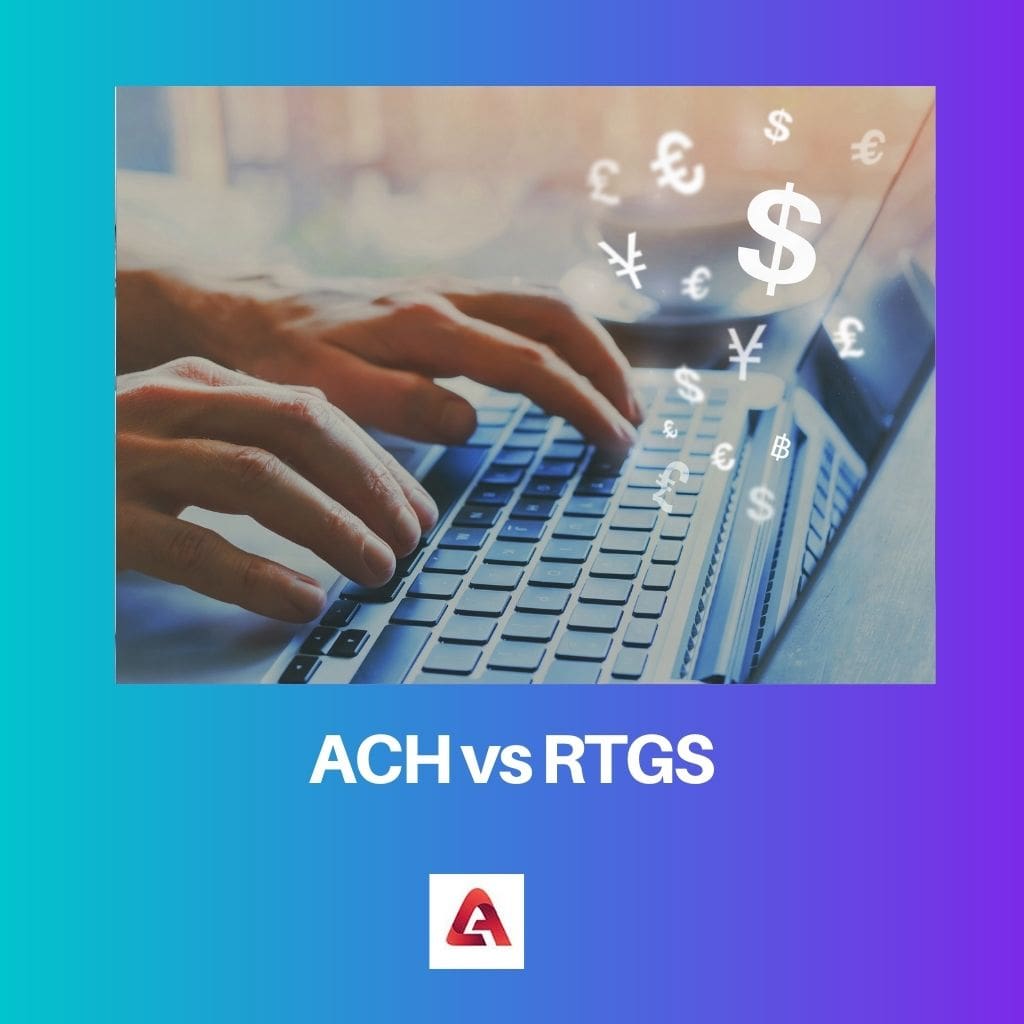ACH (Automated Clearing House) is a batch processing system for electronic funds transfers, typically used for low-value, high-volume transactions, offering slower settlement times but lower fees. RTGS (Real-Time Gross Settlement), on the other hand, processes high-value transactions individually and in real-time, ensuring immediate and irrevocable funds transfer with higher fees but faster settlement, making it ideal for urgent and large transactions.
Key Takeaways
- ACH (Automated Clearing House) is a batch processing system for electronic financial transactions, with transactions grouped and processed at specified intervals; RTGS (Real-Time Gross Settlement) processes high-value transactions individually and in real time.
- ACH transactions are lower in value, while RTGS transactions require a minimum threshold and are used for urgent, high-value transfers.
- ACH transactions are more suitable for everyday and recurring payments, whereas RTGS is designed for time-sensitive, large-sum transfers needing immediate settlement.
ACH vs RTGS
ACH (Automated Clearing House) transfers are batched and settled in batches, where transactions are grouped together and processed. RTGS (Real-Time Gross Settlement) transfers are settled in real-time, meaning that they are processed immediately and funds are transferred between banks instantly.

ACH stands for Automatic Clearing House. It is a payment system introduced in the United States of America during the 1970s.
RTGS stands for Real-Time Gross Settlement and is the fastest way of transferring money. In this process, money from one Bank is transmitted in real-time and on a gross basis.
Comparison Table
| Feature | ACH (Automated Clearing House) | RTGS (Real-Time Gross Settlement) |
|---|---|---|
| Settlement Time | Batched: Transactions are processed and settled in batches at specific times throughout the day, typically taking 1-3 business days to complete. | Real-time: Transactions are settled immediately, one transaction at a time. |
| Speed | Slower: Not ideal for urgent payments. | Fastest: Best for time-sensitive transactions. |
| Transaction Size | No minimum or maximum limits for most transactions. | May have minimum transaction size limits depending on the system. |
| Cost | Typically lower fees compared to RTGS. | May have higher fees due to the real-time processing and potential minimum transaction size. |
| Availability | Widely available in the United States and other countries with similar systems. | Less widespread compared to ACH, typically offered by central banks or specific institutions. |
| Use Cases | Recurring payments: payroll, direct deposit, bill payments, person-to-person transfers. | Large, urgent payments: interbank transfers, high-value transactions, time-critical settlements. |
What is ACH?
Origin and Functionality:
ACH was established in the United States in the 1970s as a more efficient alternative to paper checks for processing payments electronically. It operates as a batch processing system, where transactions are grouped together and processed in batches at specific intervals throughout the day.
Process and Settlement:
- Initiation: ACH transactions can be initiated by individuals, businesses, or financial institutions. The initiator provides authorization and pertinent transaction details, such as the recipient’s bank account information and the amount to be transferred.
- Transmission: The transaction details are submitted to the ACH network, typically through a bank or a third-party service provider. The network then routes the transactions to the appropriate receiving banks.
- Clearing and Settlement: Upon receiving the transactions, the ACH network sorts and processes them, debiting funds from the sender’s account and crediting them to the recipient’s account. Settlement times for ACH transactions typically range from one to three business days, depending on the specific rules and regulations governing the ACH network.
Types of Transactions:
ACH supports various types of electronic payments, including:
- Direct Deposits: Employers use ACH to deposit salaries and wages directly into employees’ bank accounts.
- Preauthorized Payments: Consumers authorize recurring payments, such as utility bills or mortgage payments, to be automatically debited from their bank accounts.
- Business-to-Business Payments: ACH facilitates business-to-business transactions, such as vendor payments and supply chain transactions, offering a cost-effective and efficient alternative to paper checks.
Benefits and Drawbacks:
- Cost-Effective: ACH transactions typically incur lower fees compared to other forms of electronic payments, making them a cost-effective solution for businesses and individuals.
- Efficiency: ACH streamlines payment processes, reducing the reliance on paper checks and manual payment handling.
- Settlement Times: While ACH offers cost savings and convenience, its batch processing nature results in longer settlement times compared to real-time payment systems like RTGS (Real-Time Gross Settlement).

What is RTGS?
Overview and Functionality:
RTGS systems enable the real-time processing and settlement of high-value transactions, typically above a certain threshold, such as interbank transfers, large commercial transactions, and financial market transactions. Unlike batch processing systems like ACH, RTGS settles transactions individually and instantaneously, providing immediate availability of funds upon completion of the transaction.
Process and Settlement:
- Initiation: RTGS transactions are initiated by the sending party, providing authorization and relevant transaction details, including the recipient’s bank account information, amount, and any accompanying instructions.
- Transmission: The transaction details are transmitted electronically to the RTGS system, either directly by the sending bank or through an intermediary service provider. The RTGS system verifies the sender’s account balance and ensures the availability of funds for the transaction.
- Real-Time Settlement: Upon verification, the RTGS system processes the transaction in real-time, debiting funds from the sender’s account and crediting them to the recipient’s account instantly and irrevocably. This instantaneous settlement eliminates counterparty risk and ensures that funds are immediately available for use by the recipient.
Features and Benefits:
- Immediate Settlement: RTGS offers immediate and final settlement of transactions, reducing counterparty risk and providing certainty of funds availability.
- High-Value Transactions: RTGS systems are designed to handle large-value transactions efficiently, making them suitable for interbank transfers, corporate payments, and financial market transactions.
- Real-Time Monitoring: Participants in the RTGS system have access to real-time monitoring and tracking of transactions, enabling better liquidity management and risk mitigation.
- High Security: RTGS systems employ robust security measures to safeguard transactions and protect against fraud and unauthorized access.
Limitations and Considerations:
- Cost: RTGS transactions often incur higher fees compared to batch processing systems like ACH, reflecting the premium placed on real-time settlement and liquidity management.
- Thresholds: RTGS systems may impose minimum transaction thresholds, limiting their utility for smaller-value transactions.
- Operational Hours: RTGS systems typically operate during specific business hours, which may limit their availability for processing transactions outside of regular banking hours.

Main Differences Between ACH and RTGS
- Settlement Speed:
- ACH: Settlement occurs in batches and typically takes one to three business days.
- RTGS: Settlement happens in real-time, with immediate availability of funds upon completion of the transaction.
- Transaction Value:
- ACH: Primarily used for low-value transactions, such as payroll deposits, bill payments, and vendor payments.
- RTGS: Designed for high-value transactions, including interbank transfers, large commercial transactions, and financial market transactions.
- Processing Method:
- ACH: Operates as a batch processing system, where transactions are grouped together and processed at specific intervals throughout the day.
- RTGS: Processes transactions individually and instantaneously, ensuring immediate and irrevocable transfer of funds.
- Fees and Costs:
- ACH: Typically incurs lower fees compared to RTGS, making it a cost-effective solution for routine payments.
- RTGS: Involves higher fees due to the premium placed on real-time settlement and liquidity management.
- Risk and Security:
- ACH: Offers lower immediate settlement risk compared to RTGS, as transactions are processed in batches and may be subject to reversal or adjustment.
- RTGS: Provides immediate and final settlement, reducing counterparty risk and offering enhanced security against fraud and unauthorized access.
- https://www.cribfb.com/journal/index.php/amfbr/article/view/289
- https://papers.ssrn.com/sol3/Delivery.cfm?abstractid=1485141#page=88
- http://www.bankandcredit.nbp.pl/content/2003/2003_04/tochmanski.pdf

The article effectively navigates the complexities of ACH and RTGS, shedding light on their distinct characteristics. It’s an enlightening read for those seeking clarity on payment systems.
Indeed, Sonia88. The article succeeds in demystifying the intricacies of ACH and RTGS, making this vital information accessible to a wide audience.
The lucid exposition of ACH and RTGS in this article is both illuminating and engaging. It serves as a valuable resource for anyone delving into financial mechanisms.
The historical background and evolution of ACH and RTGS systems provide valuable context for understanding their significance in modern banking. It’s intriguing to learn about their origins and development.
The detailed overview of ACH and RTGS is both informative and thought-provoking. It’s a testament to the complexity and sophistication of modern financial infrastructure.
Absolutely, Thomas Isabelle. Recognizing the foundations of these systems can deepen our appreciation of their role in today’s financial landscape.
The ACH and RTGS systems have their distinct features that cater to different types of financial transactions. Understanding these differences is crucial for effective financial management.
I found the comparison table to be particularly helpful in highlighting the key disparities between ACH and RTGS. It’s a valuable resource for anyone navigating payment systems.
Well said, Fcox. It’s important to consider the risks and processing differences between ACH and RTGS to make informed decisions about payments.
The historical context and technological underpinnings of ACH and RTGS are explored with precision in this article. It’s a testament to the depth of research and analysis undertaken.
Absolutely, Steve27. The scholarly approach to elucidating the origins and functionalities of ACH and RTGS elevates the quality of the article.
The intellectual rigor applied to the exposition of ACH and RTGS is commendable. It reflects a commitment to delivering accurate, comprehensive information to readers.
The efficiency and reliability of RTGS for high-value transactions are underscored in this article. It’s evident that precise, immediate settlements are essential for certain financial needs.
I appreciate the detailed comparison between ACH and RTGS systems. It’s helpful to know the specific use cases and ideal scenarios for each system.
Absolutely, Anna58. Having this knowledge can empower individuals and businesses to choose the most suitable payment method for their needs.
I found the explanation of ACH and RTGS to be clear and concise. It’s essential information for anyone involved in financial transactions.
The evolution of transfer and distribution systems is fascinating. It’s interesting how banks offer multiple plans for payments and settlements based on the needs of their customers.
That’s true, Beth00! It’s amazing to see how these systems have developed over time to cater to different types of financial transactions.
Indeed, the comparison between ACH and RTGS is enlightening. It’s crucial for individuals and businesses to understand the differences to make informed decisions.
The practical examples of ACH and RTGS transactions make this article highly informative. It’s helpful to see real-world applications of these systems.
The article successfully bridges the knowledge gap by using relatable examples to explain ACH and RTGS. This approach makes complex topics more approachable.
Absolutely, Alan22. Understanding the tangible implications of ACH and RTGS in everyday transactions enhances our grasp of these concepts.
The distinction between ACH and RTGS systems is well-articulated. It’s refreshing to see such clear explanations of intricate financial processes.
I agree, James Rob. The clarity of the article makes it accessible to a wide audience, regardless of their familiarity with financial terminology.
The comparison table effectively showcases the contrasting attributes of ACH and RTGS. It’s a valuable resource for individuals seeking a quick reference to differentiate between the systems.
The detailed breakdown of ACH and RTGS parameters in the comparison table enriches the reader’s understanding of the nuanced differences between the systems.
Agreed, Isobel Kelly. The comparison table succinctly captures the key characteristics of ACH and RTGS, making it a practical tool for analysis.